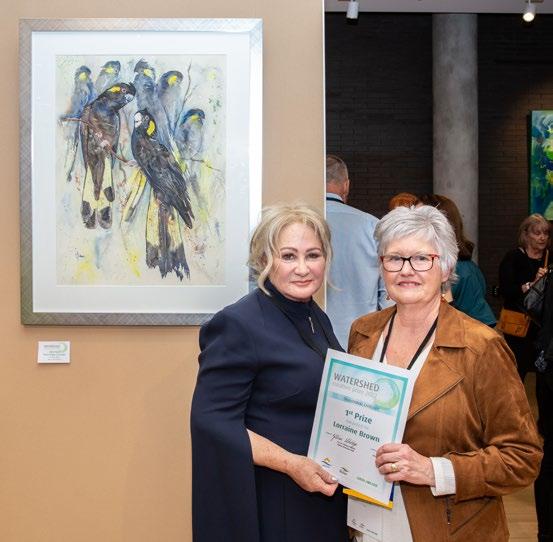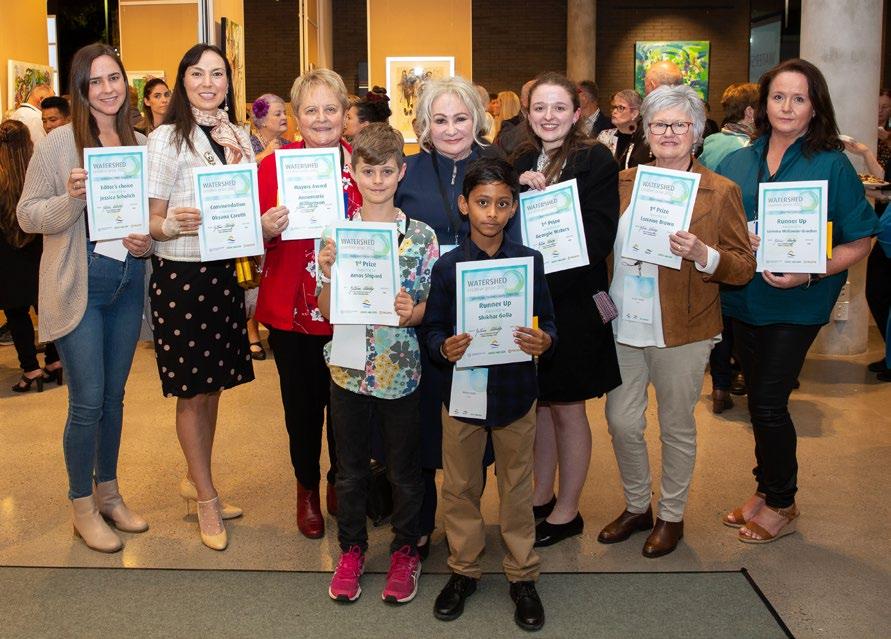
4 minute read
Creativity with a focus on sustainability
WORDS Linda Sim
The City of Salisbury is leading the way in sustainability. Over the years, land across the City has been transformed into beautiful environmentally conscious parks with biofiltered water management and measures to support biodiversity.
Advertisement
Another way the City of Salisbury has encouraged its sustainability mindset and green focus is through this year’s Watershed Creative Prize.
The Watershed Creative Prize, which has run since 2008, offers both budding and established artists in South Australia an opportunity to showcase their art on the theme of sustainability for a cool cash prize.
This year, the winning entry of each category won $2000 and runners up won $500. A special prize of $1000 was awarded for Young Emerging Artist.
Originally more focused on water as a precious natural resource and conservation, the Watershed Creative Prize now embraces the concept of sustainability more broadly, giving artists greater options to show what sustainability means to them.
The categories have also been expanded in recent years to allow newer mediums aside from painting and sculpture. Artists and creative people can now submit work in written and emerging technologies categories such as film making and podcasts, giving more avenues for interested artists to employ their creative genius to convey the theme.
Mayor Gillian Aldridge OAM and Traditional Category first prize winner Lorraine Brown standing in front of her artwork.
There are great submissions from all ages every year and 2022 was no exception. As with previous years, entries comprised classic and modern renditions of South Australia’s wildlife and waterways in acrylics, oil paints, photography and sculpture.
This year also saw an exciting range of nontraditional submissions, including slam poetry, stop motion film, wearable sculpture, and even video performance.
Many pieces used recycled materials in the spirit of environmentalism and sent messages of caution and awareness about the need for respect for the Earth, as well as drawing attention to the beautiful creatures at risk.
Winners were announced on April 29 2022 and all works submitted were on display at the Salisbury Community Hub until June 12 2022.
This year’s traditional category winner was Lorraine Brown with a stunning watercolour painting, ‘Do They Listen.’ Brown’s artwork depicts a group of yellow-tailed cockatoos whose numbers have declined due to disruption of their ecosystem from habitat fragmentation and land conversion around Australia’s coastline, where they are typically found in mild climates.

Jessica Scholich (back, left), Oksana Caretti, Annemarie Williamson, Mayor Gillian Aldridge OAM, Georgie Waters, Lorraine Brown, Gemma McGowan-Graeber, Amos Shipard (front, left) and Shikhar Golla.
“I love painting cockatoos,” Brown said. “It’s a shame that they become vulnerable because of how we use the land. Salisbury is great because it has dedicated areas for bird sanctuaries and waterways.”
Brown first dabbled in watercolours in the nineties but only began an artist’s life in 2012 after a busy business career. In retirement, her passion for watercolour came alive.
“I found the paints again and started painting for 35 hours a week,” Brown continued. She started holding art classes and workshops where she was living in Goolwa and now continues to teach art around Adelaide.
She considers her works ‘expressive impressions’ that blend realism and abstraction to create unique and impactful art.
“I like to paint in a loose, expressive way. I work intuitively. I start out with an idea but I never quite know where the work is going till I finish the previous brushstroke,” Brown said. “I’m just happy to have my work seen. I’m glad that watercolour works have been getting more attention in recent times.”
Taking the prize for best in the written category was Georgie Waters, who usually works on short stories and poetry on the topic of mental health.
Her writing is informed by her own experience living with clinical obsessive disorder, and she hopes to reduce the stigma surrounding people with mental health issues.
Furthering the sustainability cause is a new field she has begun to delve into and certainly impressed the judges with her piece this year.
Lastly, the winners for the emerging technologies category were the students of St Paul’s College Class of 2022 with their digital reproduction of Dry Creek. Their virtual model shows the types of flora and fauna in the area and draws attention to the problems the area faces from pollution, invasive species, and erosion.
“People don’t really know what’s down there. The model highlights biodiversity and what’s in the creek,” teacher Susan O’Malley said.
“We’re sometimes shocked by the rubbish we find there and clean up. Looking after the creek has given a sense of accountability in the students. They’re now much more concerned about keeping rubbish out of it.” The student model included an inventive solution for its rubbish problem using a movable slide and metal net as a catchall.
Submissions for the Watershed Creative Prize were also optionally for sale and those that did not win were still well received by the public. Pieces that sold included beautiful jacaranda trees in blown glass, watercolour works of pelicans, photos of the Australian coastline, and earrings made from recycled coffee pods.










